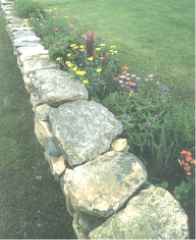|
Knowledgeable Staff - Quality Products |
|
||
|
|
|
|
||
|
|
|
|
|
Knowledgeable Staff - Quality Products |
|
||
|
|
|
|
||
|
|
|
|
 ANDY'S
GARDEN TIPS - VOL. 4 #2 ANDY'S
GARDEN TIPS - VOL. 4 #2
1/31/2003 |
|
|
 Stone
Work In The Garden Stone
Work In The Garden |
The use of “dry stacked” rock walls has become immensely popular in the landscape in the last decade. Stone walls and borders give our gardens a sense of definition while adding a sense of nature to our garden.
The very first gardening book I acquired was America’s Garden Book by James and Louise Bush-Brown. The book was first published in 1958 and last printed in 1967. I was born in 1958…Ford Motor Company made the “Edsel” in 1958…I became an Oakland Raider fan in 1967 (but let’s not talk about that this week)…I got my copy of America’s Garden Book in 1975. The Bush-Browns’ describe one wall as “An unusual wall found in Virginia and supposed to be the invention of Thomas Jefferson is the serpentine wall of brick”.
If one visits old farms and Civil War battlefields, they will frequently find split rail fences laid in a “zig-zag” fashion. The “zig-zag” pattern adds stability to the fences. It also confuses the dickens out of cattle, as they are not “the sharpest tools in the shed”. It is easy to see that serpentine or “zig-zag” patterns lend stability to fences. A perfectly straight wall with no supports is likely to fall.
In nature, patterns tend to be more random. As I have often said, we follow Mother Nature’s lead. Thus the term “discovery”. The “Big Mom” figured out long before Tom Jefferson that high structures in a straight line tend to topple. Having adapted to such curvature, we feel more at peace with such structures.
More than ten years ago, my friend and co-worker Herb ordered a truckload of palletized stone. We started out selling it at 15 cents per pound. I said, “Herb, are you nuts!” Low and behold, we just can’t get enough stone these days.
The primary origin of our stone is north central Pennsylvania. Back in “the day”, when fields were plowed with animals, large rocks were a recurring problem to the farmer. It seems the rocks were drawn to the surface by the power of the Moon. After all, the Moon can change the tides. In reality, soil science teaches us that bedrock constantly moves towards the surface as the particles become smaller. I once sat in the backyard and tried to observe this phenomenon first hand, but I soon grew very tired.
Back to the story… The farmers would collect the rocks as they plowed the fields, tossing them aside. On the way back home at dusk the farmers would stack the rocks on the edge of the field for two reasons. The primary reason was to get the rocks out of the way so they could plant their crops. The secondary benefit of this activity was to corral those brilliant cows. Sadly, as progress settles on these farms, these stone walls are being dismantled to make room for people’s houses. Entrepreneurial Pennsylvanians have taken to stacking these rocks on pallets and selling them to far away places such as our store. Yes, we have only “plantation grown” stone. None of this material has been harvested from the wild.
Should you be contemplating a stone wall or border, calculate the average width and height of your wall. Then multiply this by the length of the wall. This will give you the amount of cubic feet required for your project. As an example, a border with an average width of 8 inches, an average height of 15 inches, and a length of 32 feet will require approximately 27 cubic feet of stone. (.67 feet x 1.25 feet x 32 feet = 26.8 cubic feet).
Don’t feel too bad about buying imported stone. We’re not destroying matter, just moving it around. Besides, it would be tough to re-bury all of those rocks again. I don’t think the mule teams could stand it. Until next week.
Andy Lynn